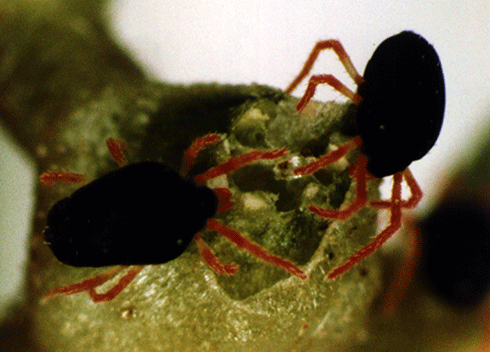
|
Published: 17 July 2014
Rainfall and temperature keys to redlegged earth mite emergence
Models identifying weather conditions that trigger redlegged earth mite egg hatchings in different regions will allow growers to more accurately predict when they need to look out for this challenging little pest.

|
|
Two redlegged earth mites. Rainfall and temperature act together to regulate this mite’s egg development and hatch. Credit:
CSIRO
|
The redlegged earth mite has been a major pest of pastures, crops and vegetables in winter rainfall areas of southern Australia since its introduction from South Africa in 1917. It causes an estimated $200 million annual loss in production, sucking the fluid out of plant cells leaving them full of air, giving the damaged areas a characteristic silvery look.
Increasing resistance to some classes of insecticides is making the mite even more challenging to control.
To assist growers in parts of Australia where redlegged earth mite is present, Dr Garry McDonald at the University of Melbourne has been developing models that predict the risk of a redlegged earth mite outbreak each season based on the weather patterns in a region. Dr McDonald’s work forms part of the National Invertebrate Pest Initiative (NIPI) and is funded by GRDC, CSIRO and the University of Melbourne.
In western and south-eastern Australia, redlegged earth mite is generally active in the cool, wet part of the year (April to November). Eggs laid in spring go into a suspended growth state, or diapause, over summer to protect them from desiccation.
Identifying the specific weather conditions that trigger egg hatch as the autumn weather cools is crucial to Dr McDonald’s models. Discovering these triggers will allow growers to more accurately predict when to watch out for redlegged earth mite in their fields.
To discover exactly what these triggers are, Dr McDonald compiled data from various research trials conducted over the past 50 years by state departments, CSIRO and universities. He is now using this data to tease out the climate triggers for egg hatch.
‘So far I have quantified how rainfall and then temperature act in concert to regulate egg development and hatch,’ Dr McDonald says. ‘Interestingly, the triggers in the western region appear different to those in the southern-eastern region. This supports earlier research findings that suggest there may be undocumented differences between populations in the western and southern-eastern regions.’
Once these triggers are validated across a range of sites, Dr McDonald can determine if they will be useful for growers currently managing redlegged earth mite, and if different management strategies should be developed for the two regions.
Source: CSIRO



